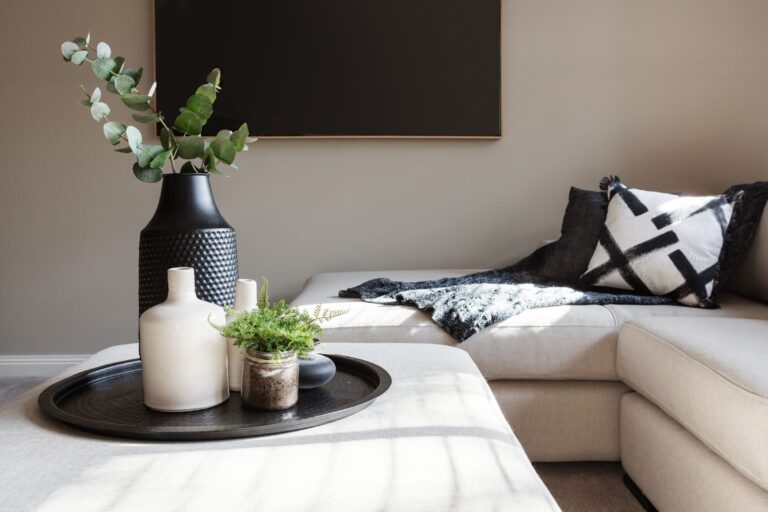Running an interior design business is equal parts creativity and strategy—one minute, you’re dreaming up gorgeous spaces, and the next, you’re managing timelines, budgets, and client expectations. It’s a lot, but when you have the right systems in place, everything runs smoother (and you get to spend more time doing what you love!).
Whether you’re just starting out or looking to refine your process, learning how successful designers juggle it all can be a total game-changer. From daily must-dos to long-term business growth, this guide breaks down the essential tasks that keep your design business running like a well-styled dream.
Table of Contents
How to run an interior design business
When you’re learning the ropes of running an interior design business, start by evaluating your skills. Thriving in this industry requires a unique blend of creative talent, client communication, and business management expertise.
Creative talent:
- Visualizing and bringing to life stunning interiors from scratch
- Understanding a variety of design styles (traditional, modern, minimalist, etc.) or specializing in a signature aesthetic
- Keen attention to detail
- Staying ahead of trends and emerging styles
- Mastering color theory, textures, and material applications
- Optimizing space planning and layout design
- Solving design challenges for small spaces, awkward layouts, and more
Communication skills:
- Active listening to ensure clients feel heard and understood
- Clear and confident verbal communication
- Professional non-verbal cues (body language, posture, and tone of voice)
- Strong writing skills for proposals, project timelines, and marketing materials
- Negotiation, presentation, and conflict resolution expertise
Business management skills:
- Time management to prioritize tasks and meet deadlines
- Project management to oversee all stages of the design process
- Financial management (budgeting, invoicing, and maintaining profitability)
- Marketing and networking through social media, email, and industry relationships
- Tech proficiency with design software, websites, and business tools
- Strategic planning for revenue growth, client acquisition, and business expansion
Are there areas where you need improvement, or do you already have a strong foundation? If you’re confident in your skills, the next step is implementing the following daily, weekly, and monthly business practices to maintain organization and efficiency.
If you need additional support, check out our full beginner’s guide to starting an interior design business.
Daily business tasks
No two days are the same for an interior designer, especially with so many different business models. However, most design professionals prioritize these key tasks:
Manage current projects
Designers spend the bulk of their time onboarding clients, creating mood boards and floor plans, sourcing and procuring products, and overseeing installations. While these tasks demand attention, it’s crucial to set aside time for other business responsibilities.
Communicate with clients
Client communication takes almost as much time as design work. Daily tasks may include:
- Answering emails and phone calls
- Scheduling and conducting discovery calls, client meetings, and site visits
- Presenting design concepts
Each client’s communication needs vary. Some prefer a hands-off approach, while others require frequent updates. To streamline communication, set clear expectations during onboarding.
Beyond current clients, don’t neglect prospective ones. Consistent follow-ups and personal outreach are key to business growth.
Weekly business tasks
These tasks don’t need daily attention but are essential for keeping your business running smoothly.
Manage project timelines and budgets
Clients expect projects to be delivered on time and within budget. This starts with a solid timeline and financial plan during onboarding, but regular progress checks are critical.
Set aside time each week to review:
- Current expenses and hours logged
- Client payments and outstanding invoices
- Task completion and project status
Interior design software like DesignFiles can simplify tracking.
Market your business
Successful designers understand that marketing is ongoing. Instead of scrambling for leads when projects slow down, maintain a consistent online presence.
Each week, try to:
- Post on social media
- Send an email newsletter
- Engage with potential clients through networking
To save time, batch-create content and schedule posts in advance.
Monthly business tasks
Schedule these tasks once a month to stay ahead of long-term goals.
Track your finances
Beyond invoicing, you’ll need to monitor cash flow, expenses, and taxes. Even if you work with a bookkeeper, having a monthly check-in on your financials helps you stay in control of your business goals.
Set aside a few hours each month to complete the following:
- Review all financials
- Reconcile accounts
- Plan for upcoming expenses
Financial tracking software or an accountant can be invaluable.
Update your portfolio
Your portfolio is one of your most powerful marketing tools. It showcases your expertise, communicates your signature style, and helps potential clients envision what’s possible when working with you. But if it isn’t updated regularly, it won’t accurately reflect your best work—or the direction your business is heading.
To keep your portfolio fresh and compelling, set aside time each month to:
- Add Recent Projects: New work demonstrates growth, versatility, and evolving trends. Include high-quality images that highlight different aspects of your designs, from layout and material selection to styling details.
- Refine Descriptions: Update project descriptions to ensure they align with your current aesthetic and messaging. Highlight design challenges you solved, key client goals, and any unique details that set the project apart. If writing isn’t your strength or you struggle to capture your design vision in words, consider investing in a copywriter who specializes in interior design. A professional can craft descriptions that elevate your work and resonate with your ideal clients.
- Ensure Image Quality and Relevance: High-resolution images are a must, but quality goes beyond resolution. Choose photos that best capture the atmosphere of the space and reflect the types of projects you want to attract. If you’re shifting your focus toward a specific niche or aesthetic, ensure your portfolio reflects that direction.
A well-maintained portfolio is more than a showcase—it’s a strategic tool for attracting your ideal clients. By making updates a regular habit, you’ll always be prepared when new opportunities arise.
Continue growing your design skills
Interior design evolves constantly, with new trends, materials, and technologies shaping the industry. Staying ahead isn’t just about keeping up—it’s about positioning yourself as a leader in your field.
Invest in opportunities that enhance your expertise and strengthen your business acumen:
- Online Courses: Stay updated on emerging design software, industry best practices, and business strategies. Platforms like Domestika, Udemy, or MasterClass offer valuable insights from top professionals.
- Industry Conferences: Attending design trade shows and conferences, such as High Point Market, Maison & Objet, or Salone del Mobile, helps you discover the latest innovations, build industry connections, and draw inspiration for future projects.
- Workshops and Certifications: Whether it’s mastering advanced rendering techniques, sustainable design practices, or the latest in lighting design, specialized training can give you a competitive edge and open new opportunities.
The more you invest in your skills, the more confidently you can take on complex projects, charge premium rates, and position yourself as a go-to expert in your niche.
Some tasks don’t follow a set schedule but are critical for maintaining a smooth workflow and delivering exceptional results for clients.
Discovery calls
One of the most important steps in the sales process, a well-run discovery call, sets the foundation for a successful project. These calls allow you to:
- Understand client needs, budgets, and timelines
- Determine if the project is a good fit for your expertise
- Communicate your creative vision and process
A strong discovery call builds trust, aligns expectations, and increases your chances of securing the project. Need to refine your approach?
To learn more about mastering the discovery call, check out our guide to crafting the best discovery call questions.
Onboard new clients
Once a client is ready to move forward, a structured onboarding process ensures a smooth, professional start. It also sets expectations for collaboration, timelines, and communication.
This process includes:
- Sending proposals and contracts to establish clear terms
- Requesting deposits to secure commitment
- Setting up client accounts in design software for easy project tracking
- Gathering room dimensions and blueprints (this may involve requesting architectural drawings or conducting on-site measurements)
- Establishing a clear project timeline with deadlines and key milestones
A well-organized onboarding process minimizes misunderstandings and keeps projects running efficiently.
Create mood boards, floor plans, and 3D renderings
This is where your creative expertise truly gets a chance to shine.
- Mood Boards: These help clients visualize their space by showcasing color palettes, textures, materials, and design elements. A strong mood board sets the tone for the entire project.
- Floor Plans: A well-planned layout ensures the space is both functional and aesthetically pleasing. This step may involve space planning, furniture arrangements, and optimizing traffic flow.
- 3D Renderings: When needed, 3D visuals help clients see the final result before construction or purchasing begins, reducing uncertainty and increasing confidence in your vision.
These design assets not only guide your project but also help clients fully understand and buy into your creative direction.
Source and procure materials, furniture, and decor
Beyond selecting materials, the sourcing process is often one of the most time-consuming aspects of a project. It requires adaptability, organization, and strong vendor relationships.
Challenges that can arise during sourcing:
- Backordered or discontinued items that require last-minute substitutions
- Delays in shipments that affect project timelines
- Coordinating temporary storage for large furniture pieces before installation
By staying proactive and maintaining strong relationships with vendors, you can mitigate challenges and keep projects moving smoothly.
Oversee construction and installation
For full-service designers, managing construction and overseeing installation is critical to ensuring that the final execution aligns with your vision.
Key responsibilities include:
- Briefing contractors and tradespeople on design specifications
- Monitoring progress and addressing unexpected issues on-site
- Conducting final walkthroughs to ensure quality and attention to detail
This stage requires strong problem-solving skills as unexpected challenges—such as last-minute structural adjustments or material delays—are common. A proactive approach and clear communication help keep the process on track.
Gather testimonials and reviews
Client reviews serve as powerful social proof, reassuring potential clients that you’re experienced, reliable, and deliver exceptional results. However, many happy clients won’t leave reviews unless asked.
Rather than hoping for testimonials, build a system for collecting feedback:
- Ask for a review at project completion while enthusiasm is high
- Set a monthly reminder to follow up with previous clients
- Compile testimonials in a dedicated folder for use in marketing, your website, and social media
Well-crafted testimonials can be repurposed into case studies, social proof on your website, and engaging social media content. Make collecting them a priority.
Streamline your entire design business with the #1-rated platform for small and solo firms. Learn more about DesignFiles.


